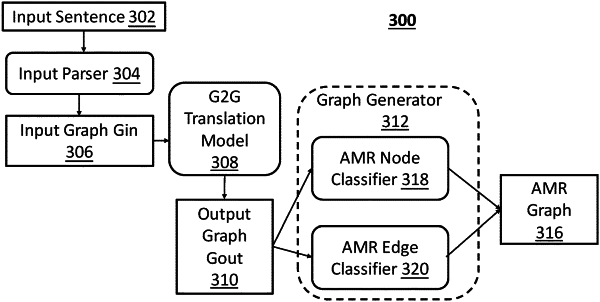| CPC G06F 40/211 (2020.01) [G06F 18/2155 (2023.01); G06N 3/045 (2023.01); G06N 3/08 (2013.01); G06N 7/01 (2023.01)] | 17 Claims |

|
1. A computer-implemented method of generating an abstract meaning representation of a sentence, comprising:
receiving, by a computing device, an input sentence;
parsing, by the computing device, the input sentence into one or more syntactic and/or semantic graphs;
forming, by the computing device, an input graph from the one or more syntactic and/or semantic graphs, the input graph including a node set including words in the one or more input sentences and an edge set including connections between words from the one or more syntactic and/or semantic graphs;
generating, by the computing device, node representations of the words in the node set by natural language processing;
predicting, by the computing device, learned node representations aligned with the node representations in the input graph based on the generated node representations and the edge set, via a first neural network;
predicting, by the computing device, node labels in an output graph via a second neural network, based on the learned node representations, by:
determining, based on the learned node representation, whether to copy a lemma from a set of lemmas or to generate the abstract concept from a concept library based on a probability to copy a lemma and the probability to generate the abstract idea, by the second neural network; and
predicting the lemma to copy or the abstract idea to generate based on the lemma in the set of lemmas or the abstract concept from the concept vocabulary that has a highest probability of being the predicted node label, by the second neural network;
predicting, by the computing device, edge labels in the output graph, via a third neural network, based on the learned node representations; and
generating, by the computing device, an abstract meaning representation graph of the input sentence, the abstract meaning representation graph having nodes with node labels based on the predicted node labels and edges between nodes based on the predicted edge labels.
|